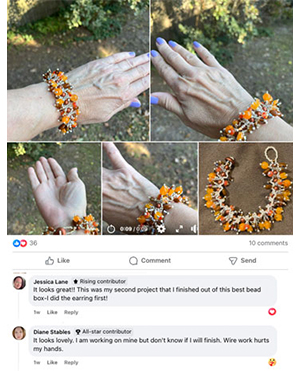- Jewelry-Making Supplies ▾
Design Jewelry with Confidence!
Seed Beads
Thread, Wire, & Stringing Materials
Athenacast Findings & Components
Everything Else
- Kits & Collections ▾
Assemble Your World
Kits & Collections
- Subscriptions ▾
Want monthly Beading Happiness?
Subscriptions
- Learn to Make ▾
Want to learn more?
- Discounts & Deals ▾
Explore Today's Promotions!
- Jewelry-Making Supplies
- Kits & Collections
- Subscriptions
- Learn to Make
- Discounts & Deals
-
Seed Beads
Thread, Wire, & Stringing Materials
Findings & Components
Everything Else
-
Kits & Collections
-
Subscriptions
- Home
- How to Make Jewelry
- Better Beader Episodes
- How to Use a Caliper
How to Use a Caliper

Watch the Video Tutorial
Watch the Video Tutorial
Need Any Extra Materials?
Need Any Extra Materials?
Need Any Extra Materials?
Need Any Extra Materials?
Episode Transcript
Episode Transcript
Introduction
In this Better Beader episode from Potomac Beads, Allie and Megan demonstrate how to use a caliper, an essential tool for any beader's toolkit. Calipers allow you to accurately measure the size of beads, findings, and other jewelry components, ensuring that your designs are precise and consistent. Whether you're a beginner or an experienced beader, mastering the use of a caliper will elevate your beading skills and open up new possibilities for your projects.
Materials Needed
- Caliper (digital or manual)
- Beads of various sizes and shapes
- Findings (clasps, jump rings, etc.)
- Beading wire or thread
- Beading mat or work surface
Step-by-Step Tutorial
- Begin by familiarizing yourself with the parts of the caliper. Identify the jaws, the depth gauge, and the display screen (if using a digital caliper).
- To measure the diameter of a round bead, place the bead between the jaws of the caliper and gently close them until they touch the bead's surface. Read the measurement on the display or the scale.
- For measuring the length of a bead or finding, use the depth gauge. Place the component against the fixed jaw and extend the depth gauge until it touches the other end. Read the measurement as before.
- When measuring irregularly shaped beads or components, take multiple measurements to ensure accuracy. Rotate the piece and measure at different points to account for any variations in size.
- Record your measurements as you go, especially if you're working on a complex project or designing a pattern. Having accurate measurements will help you make informed decisions about your design and materials.
Tips & Tricks
- Always calibrate your caliper before use to ensure accurate measurements. Most calipers have a built-in calibration function or can be manually adjusted.
- Be gentle when closing the jaws around delicate beads or findings to avoid damaging them.
- If you're working with a manual caliper, make sure to read the measurement at eye level to avoid parallax errors.
- Use a beading mat or a clean, flat surface to prevent your components from rolling away while measuring.
Conclusion
Using a caliper is a simple yet essential skill for any beader. By accurately measuring your beads and components, you can create designs that are well-proportioned, consistent, and professional-looking. With practice, using a caliper will become second nature, and you'll wonder how you ever beaded without one!
We hope this tutorial has helped you feel more confident in using a caliper for your beading projects. If you have any questions or want to share your own tips and tricks, please leave a comment below. Happy beading!
Join Our Growing Community
Join Our Growing Community




Our Testimonials
Our Testimonials
- 55772 (83.7%)
- 4785 (11.4%)
- 3283 (4.1%)
- 229 (0.4%)
- 126 (0.4%)
- Favorite Reviews
- Highest to Lowest
- Newest to Oldest
- All Ratings
- 5 ★ Reviews
- 4 ★ Reviews
- 3 ★ Reviews
- 2 ★ Reviews
- 1 ★ Reviews
Loading...
Only Visible on Admin Mode
Item Description
Designer's Material List
Project Steps
Highest Quality
Products
100% Money
Back Guarantee
Fast
Shipping
Best Teaching &
Customer Service
You'll want these emails...
Get Free Projects & Inspiration
Get Free Projects & Inspiration
- Bullet 1
- Bullet 2
- Bullet 3
Copyright © PotomacBeads











